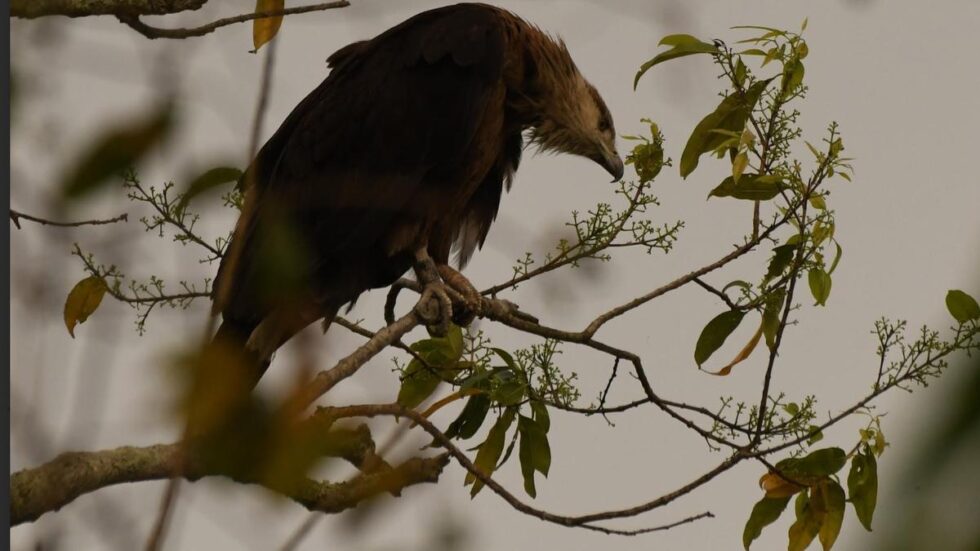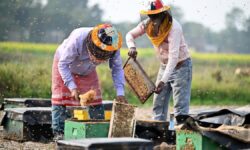
GUWAHATI
An endangered fishing eagle tagged in Mongolia continues flying to the same location in Assam’s Kaziranga National Park and Tiger Reserve for breeding season since 2020.
The Pallas’s fish eagle (Haliaeetus leucoryphus) is considered a poorly studied large bird of its kind across its flying range along the Central Asian Flyway (CAF), one of nine global waterbird migration routes.
A male raptor tagged by a Mongolian scientist at the Ulaanbaatar-based Wildlife Science and Conservation Center has provided ornithologists in India a glimpse of how it lives between two countries, about 3,000 km apart aerially.
Scientists of the Bombay Natural History Society (BNHS) recorded the bird, named Ider, on March 16 this year.
“We located Ider in the hope of finding two young Pallas’s fish eagles I tagged in 2013. We found out that this bird was tagged by D. Batmunkh of Mongolia,” Sachin Ranade of BNHS told The Hindu on Monday (April 7, 2025).
Communication with the Mongolian scientist revealed that Ider used different flight paths along the CAF to consistently reach the same destinations – Buuntsagaan Lake in central western Mongolia during the non-breeding season from June to September and water bodies in the core area of the 1,302-sq. km Kaziranga to breed from November to March.
“We observed two chicks in the tagged bird’s nest. Although we cannot say how many chicks it has sired, we can conclude it bred every year in Kaziranga for five successive years,” Dr. Ranade said.
Ider used the same nesting spot four times, shifting location just once within Kaziranga’s core area.
Sonali Ghosh, Kaziranga’s field director, said the Pallas’s fish eagle has exhibited “interesting reverse migration” behaviour as it breeds in the wetlands-rich rhino domain and flies away to Mongolia every year. “Kaziranga is one of the best locations on earth to observe this bird, one of the largest fishing eagles,” she said.
Flying by instinct
Like many big birds, the Pallas’s fish eagle is known to pair for life (monogamous) but usually migrates individually after breeding.
“Once they breed, they don’t need to stay together. They form a pair again when it is time to breed and produce an average of two chicks a year,” Dr. Ranade said.
The chicks become independent in two months, fish and hunt other birds and mammals, and fly off to Mongolia. “They don’t need parental guidance, flying by instinct to navigate the CAF,” he said.
According to Birdlife International, the range of the Pallas’s fish eagle has retracted significantly; it is largely absent from its former strongholds such as the Caspian and Kazakhstan. It is estimated that there are 2,500 mature individuals of the bird in the wild.
Chief Minister Himanta Biswa Sarma noted Ider’s annual trips to Kaziranga as “putting Assam on the map of epic bird migrations”.
Three flyways
India is located in the heart of the CAF, comprising migratory routes from Siberia to West and South Asia. Covering at least 279 populations of 182 migratory waterbird species, the flyway spans 30 countries of North, Central, and South Asia, apart from the Trans-Caucasus.
India hosts about 370 migratory bird species from three major flyways – the CAF, East-Asian Australasian Flyway (EAAF), and the Asian East African Flyway – with 310 species predominantly using wetland habitats covering 15.26 million hectares.
Kaziranga, a UNESCO World Heritage Site, and other wetlands in northeastern India serve as wintering grounds for birds using the CAF and EAAF.
While many telemetry studies on raptors investigating their movement and migration patterns have been carried out worldwide, less than 1% of the total bird species found in India have been studied using satellite telemetry.
Known more for its Big Five – one-horned rhino, tiger, elephant, wild water buffalo, and swamp deer – Kaziranga is also home to more than 500 bird species, as more than 50% of its landmass is under grasslands interspersed with beels (water bodies).
The sixth Kaziranga waterbird survey in January yielded 124 species of water and wetland-dependent birds, totalling 112,062 individuals from 25 families across 189 beels. Notably, 62 species were winter migrants, the Pallas’s fish eagle among them.







